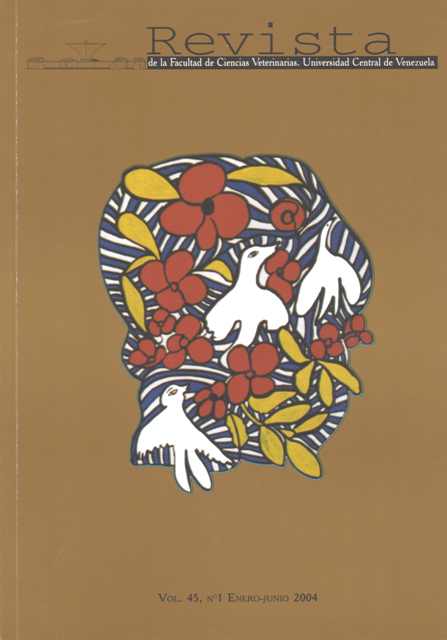USO DE CONTROLES PROFILÁCTICOS Y TERAPÉUTICOS DE COCCIDIOSIS EN CORDEROS TROPICALES
Contenido principal del artículo
Resumen
A fin de evaluar el uso de dos coccidiostáticos profilácticos en corderos en fase de crecimiento temprano y su efectividad en comparación con un tratamiento terapéutico de uso común en un rebaño ovino experimental, sobre el control de Eimeria spp. presentes de manera natural en estos animales, se realizó un ensayo en la Facultad de Agronomía-UCV. Se utilizaron 18 corderos con sus madres, distribuidos en números iguales (n=6) en tres tratamientos; cada tratamiento fue ubicado en un corral semitechado. La alimentación de las ovejas consistió en pasto picado (Pennisetum purpureum) y concentrado a razón de 500 g/día; los corderos recibieron concentrado ad libitum a partir de la tercera semana de vida y fueron sometidos a los siguientes tratamientos: T1: aplicación terapéutica con sulfas (Trisulfamida®), a partir de cargas mayores a 8.000 ooquistes/g heces (opg); T2: tratamiento profiláctico con amprolium en la 4ta semana de vida del cordero y T3: tratamiento profiláctico de toltrazuril (Baycox®) en la 4ta semana de vida. Las mediciones realizadas fueron: determinación de la calidad nutricional del pasto y concentrados ofrecidos, identificación de las especies de Eimeria presentes, control de las poblaciones de Eimeria spp. en los corderos en las semanas 4, 6, 8, 10, 12 y 14 de vida (recuentos de opg) y pesaje semanal de los animales. No se encontraron diferencias significativas entre las cargas de Eimeria spp. promedios por tratamiento (T1: 10.324±14.556, T2: 15.972±20.880, T3: 11.751±17.096 opg heces) y los pesos promedios al destete (T1: 12,05±1,32, T2: 11,01±1,34, T3: 12,01±1,45 kg), resultando igualmente efectiva la aplicación de coccidiostatos profilácticos como la del tratamiento terapéutico en corderos en crecimiento temprano.
Use of Preventive and Therapeutic Coccidiosis Controls in Tropical Lambs
ABSTRACT
In order to evaluate the effect of two preventive coccidiosis control on the early growth of lambs naturally infected with Eimeria spp. in comparison with a therapeutic treatment of common use in the experimental sheep herd, an assay was realized in the Agronomy Faculty-UCV. There were used 18 lambs and their ewes, which were distributed in three treatments and each one allocated in partially roofed pens. The feeding of the sheep consisted in cutted grass (Pennisetum purpureum) and concentrate (500 g/day). The lambs received concentrate ad libitum to from the third week of life and were assigned to the following treatments: T1: therapeutic application with sulfas (Trisulfamida®), when oocytes/g faeces (opg) were higher than 8,000; T2: prophylactic treatment with amprolium at the lamb 4th week of life and T3: prophylactic treatment with toltrazuril (Baycox®) at the lamb 4th week of life. The measurements were: determination of the nutritional quality ofgrass and concentrates, identification of Eimeria species, control of lambs’ Eimeria spp populations (counts in weeks 4, 6, 8, 10, 12 and 14 of life) and weekly weighing of animals. No significant differences were found between the average Eimeria spp charges by treatment (T1: 10,324±14,556, T2: 15,972±20,880, T3: 11,751±17,096 opg) and the average weight to weaning (T1: 12.05±1.32, T2: 11.01±1.34, T3: 12.01±1.45 kg), turning out to be equally effective the application of preventive coccidiosis controls than the therapeutic treatment in early growing lambs.
Use of Preventive and Therapeutic Coccidiosis Controls in Tropical Lambs
ABSTRACT
In order to evaluate the effect of two preventive coccidiosis control on the early growth of lambs naturally infected with Eimeria spp. in comparison with a therapeutic treatment of common use in the experimental sheep herd, an assay was realized in the Agronomy Faculty-UCV. There were used 18 lambs and their ewes, which were distributed in three treatments and each one allocated in partially roofed pens. The feeding of the sheep consisted in cutted grass (Pennisetum purpureum) and concentrate (500 g/day). The lambs received concentrate ad libitum to from the third week of life and were assigned to the following treatments: T1: therapeutic application with sulfas (Trisulfamida®), when oocytes/g faeces (opg) were higher than 8,000; T2: prophylactic treatment with amprolium at the lamb 4th week of life and T3: prophylactic treatment with toltrazuril (Baycox®) at the lamb 4th week of life. The measurements were: determination of the nutritional quality ofgrass and concentrates, identification of Eimeria species, control of lambs’ Eimeria spp populations (counts in weeks 4, 6, 8, 10, 12 and 14 of life) and weekly weighing of animals. No significant differences were found between the average Eimeria spp charges by treatment (T1: 10,324±14,556, T2: 15,972±20,880, T3: 11,751±17,096 opg) and the average weight to weaning (T1: 12.05±1.32, T2: 11.01±1.34, T3: 12.01±1.45 kg), turning out to be equally effective the application of preventive coccidiosis controls than the therapeutic treatment in early growing lambs.
Descargas
Los datos de descargas todavía no están disponibles.
Detalles del artículo
Número
Sección
Artículos de Investigación

